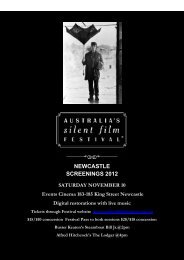SUPPORT TRADEWINDS and EAST TIMOR PROJECT 264 Pitt ...
SUPPORT TRADEWINDS and EAST TIMOR PROJECT 264 Pitt ...
SUPPORT TRADEWINDS and EAST TIMOR PROJECT 264 Pitt ...
Create successful ePaper yourself
Turn your PDF publications into a flip-book with our unique Google optimized e-Paper software.
Men of Timor (1942 – Australia)<br />
Tickets: $20/$15 concession <strong>and</strong> children<br />
Duration: 8 minutes<br />
July 27<br />
This short but important documentary propag<strong>and</strong>a film about the guerrilla warfare<br />
activities of the Australian forces on Timor during World War II is the work of<br />
Damien Parer, Australia’s most famous official war photographer. Praised for the<br />
Academy Award-winning newsreel Kokoda Front Line, Parer’s success lay in his<br />
deep desire to draw to public attention the conditions under which Australians were<br />
fighting.<br />
Parer’s work showed the human experience of conflict, making a deep impression on<br />
Australian audiences. Technically brilliant, “his films were narratives about the<br />
human situation”. Working right on the front line, he often took great personal risks,<br />
<strong>and</strong>, unfortunately, in September 1944, keen to get shots of the faces of advancing<br />
soldiers, Parer was walking backwards behind a tank when he was killed by a burst of<br />
Japanese machine gun fire.<br />
This fine example of his work, undertaken in 1942 with his war correspondent, Bill<br />
Marien, depicts the plight of Australian soldiers who remained in Timor behind<br />
enemy lines, waging their own guerilla war against the Japanese. The film was<br />
enthusiastically received, <strong>and</strong> is a valuable record of Australian wartime history.<br />
The Talion Punishment (1906 - France)<br />
Film: digital presentation of restored film<br />
Duration: 4 minutes, 13 seconds<br />
This delightful <strong>and</strong> surprising example of the creativity of early filmmakers was made<br />
in France in 1906 by Gaston Velle, a specialist in fantasy films. When moving picture<br />
technology first emerged on the world stage in 1896, it was successfully utilized <strong>and</strong><br />
developed by people skilled in all kinds of performing arts, including fantasy <strong>and</strong><br />
magic.<br />
As a result, the themes <strong>and</strong> subjects of early short films were quite varied, <strong>and</strong><br />
reflected the popular forms of entertainment of the day, such as stage <strong>and</strong> variety<br />
performances. The Talion Punishment is an example of this, with women dressed as<br />
butterflies, fluttering around a stage as they avoid capture, then retaliate against the<br />
butterfly-catcher.<br />
The new film technology also inspired many new ideas, such as how to create a film<br />
in colour, <strong>and</strong> as early as 1904 the French producers Pathé Frères introduced stencil<br />
colour. First, stencils were h<strong>and</strong>-cut for every frame <strong>and</strong> each colour. Black <strong>and</strong><br />
white prints of the film were laid out on long tables <strong>and</strong> then the colours were applied<br />
one at a time by a process similar to screen screening. The result is a charming short<br />
film with somewhat unnatural colours which perfectly suit the surreal theme of the<br />
film.









